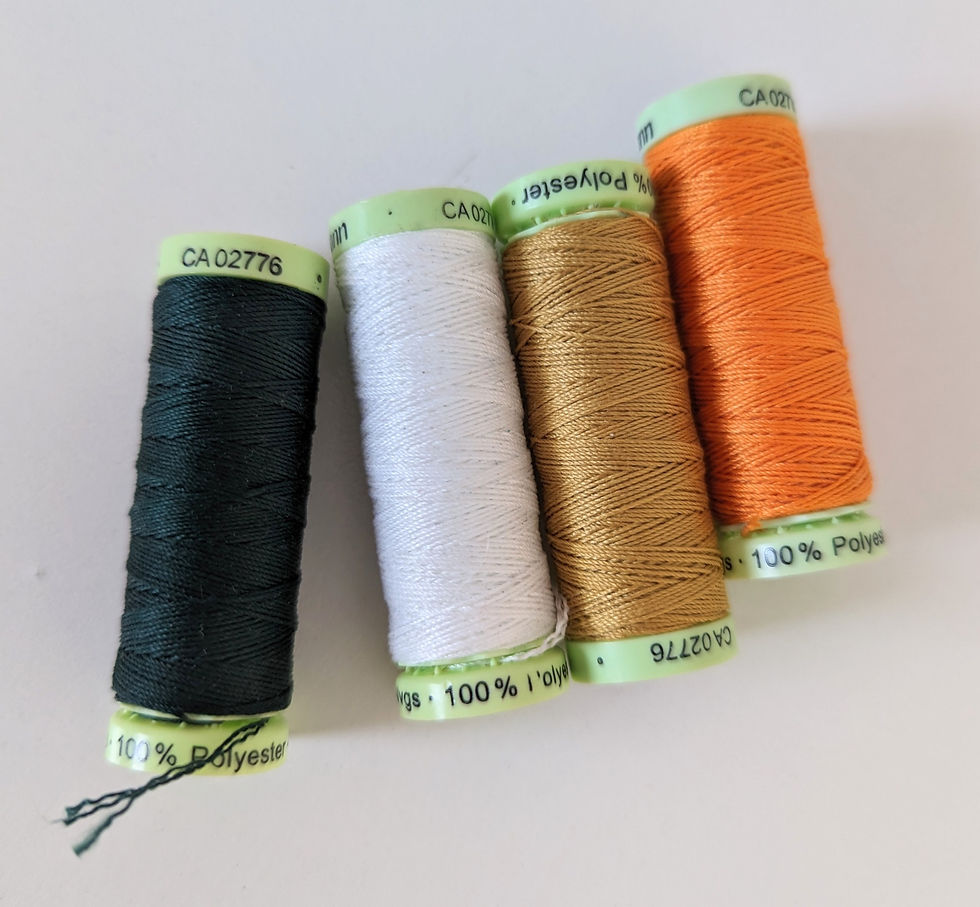Beginner's Guide to Thread for your Sewing Machine
- Amy Budd

- Nov 26, 2023
- 4 min read

Thread is one of the most fundamental parts of sewing but its often given the least thought! When you first start sewing, you usually just grab the closest reel of sewing thread that vaguely matches your fabric and to be honest, that’s fine in the beginning. However, as you progress using the correct type of thread for your project really can help you to get that professional finish that we are all striving for.
This blog post will talk about the different types of threads to consider using in your sewing machine; how to determine what is the best thread for your project and my number one top tip when choosing which thread to buy.
Different Thread Types
Polyester all-purpose thread – This type of thread is suitable for all types of sewing. Its strong and durable and generally doesn’t shrink when it goes through a washing machine. This is the type of thread that I use most of the time for my sewing. It doesn’t produce much lint which makes it kind to your sewing machine and less likely to clog it up.

Cotton thread – Cotton thread is also strong and has natural fibres which help grip onto the fabric. It can sustain high heat which is helpful when pressing seams. Its best to use cotton thread when you are sewing with fabric that also has natural fibres. You may see the term ‘mercerised’ associated with cotton thread and this just means that the thread has been treated to give it a covering which produces a smooth texture and allows it to take dye easier, therefore producing a lovely range of colours.
Top Stitching thread - This is an extra thick thread which is used for adding a feature to areas that require top stitching – a good example is on jeans or denim jackets where you have the yellow / orange stitching around pockets and other seams. It comes in a variety of colours as with all threads and can be used for sewing buttonholes by hand. It’s mainly used on heavier weight fabrics and would be too heavy a thread to use on lightweight fabrics such as cotton lawn for example. In those cases where you want to top stitch, its best to just use your normal all-purpose thread.

Elastic thread – Elastic thread is usually used to create stretch in a woven non-stretch fabric. The best example is with shirring. By using elastic thread in your bobbin and normal, all purpose, thread in your needle, you can sew lots of lines of stitching which create a lovely ‘crinkled’ textured affect which stretches when worn to produce a very comfortable garment. Elastic thread can also be used for other areas of garment sewing which need to stretch out, for example, cuffs.

Silk thread – Silk thread is very fine thread but has quite a bit of elasticity to it. It’s also very strong and can stand high temperatures when ironing and pressing. Its ideal for using with natural fibre fabrics such as wool and silk.
The above five threads are what I would say are the core threads that you will need to sew with but as with most things, there are multiple other options which you might want to think about using as you get further down your sewing journey….invisible thread, basting / tacking thread, embriodery thread, metallic thread, etc etc!
Seven Questions to ask yourself when selecting thread for your sewing project:
When deciding which type of thread to use the following are useful things to consider:
1. Are the stitches you are going to sew designed for strength and durability or are they purely decorative?
2. Will the stitches you are sewing need to stretch at all? ….if yes, consider elastic thread
3. What are the properties of the fabric you are sewing with? Often its best to match these properties to those of the thread you select both in terms of weight and thickness.
4. Will the stitches be used to sew a seam which will come under lots of pressure and stress? If yes, select a thread with good strength and durability.
5. Will the stitches be seen or basically invisible?
6. Will you need to quickly unpick the stitches at any point or are they going to be sewn into a permanent seam? ….if it’s the former, try basting thread.
7. What colour is your fabric? Its always a good idea to take a scrap of your fabric with you to buy your thread so that you can colour match as accurately as possible.
My Number One Top Tip When Selecting Thread for Sewing!
….Don’t be tempted to buy cheap! Its so important to buy a good quality thread from a reputable brand to ensure that your stitches are secure. It can be very tempting to buy any old thread reels that are on offer in the sewing shop but my advice is that is a false economy. Bargain thread is often poor quality that will shred as you sew causing a build up of lint in your sewing machine or it just snaps mid seam which is highly frustrating!! Always buy the best quality thread you can afford and my recommendation is either Guttermann or Mettler.
So there are my thoughts on thread for any beginner sewists out there. Do you have a favourite thread which you sew with? Let me know in the comments!








Comments